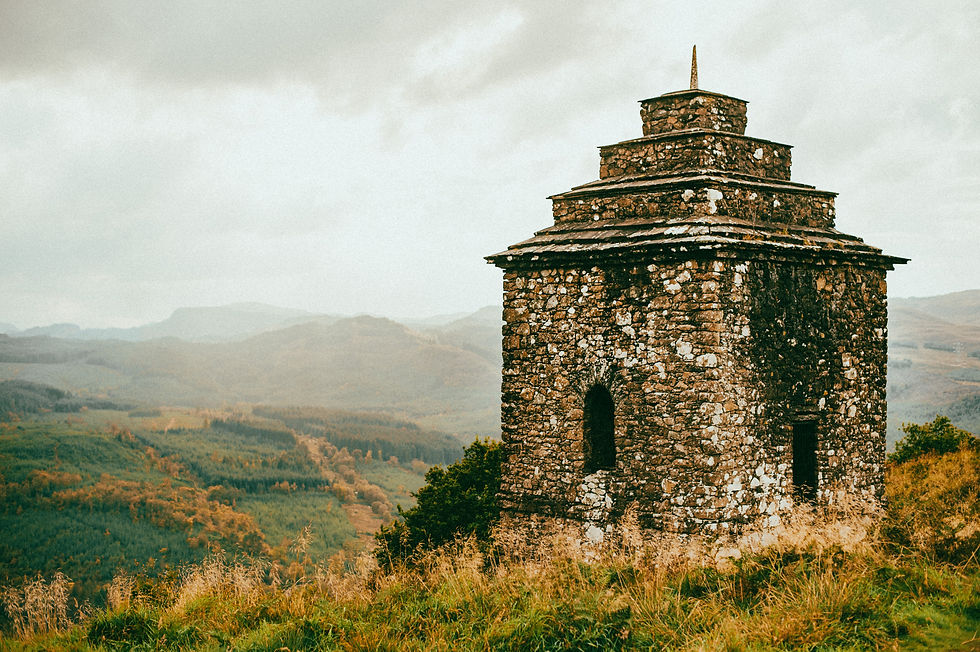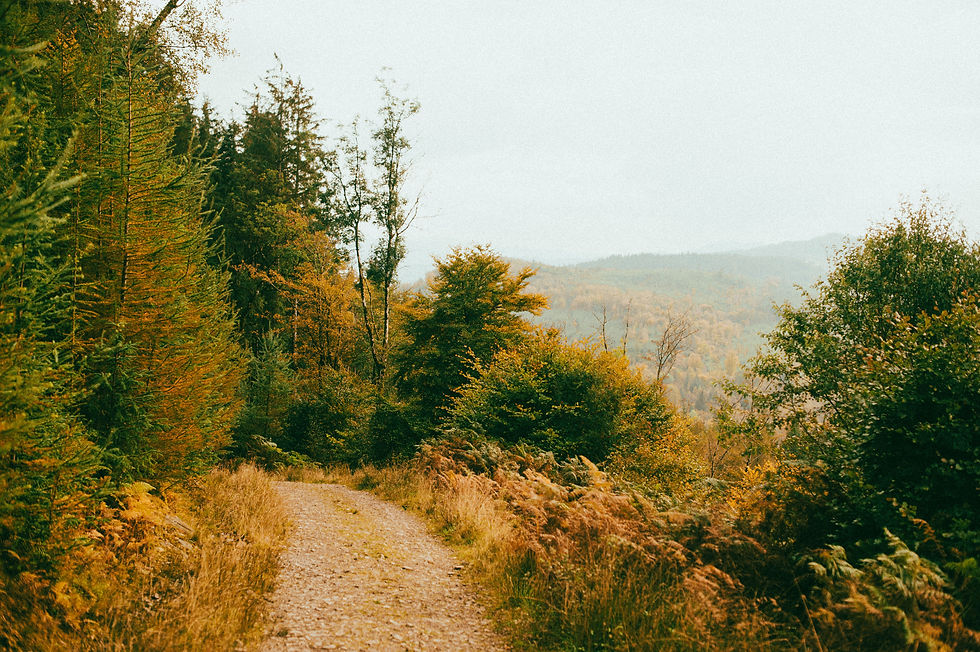
The Dun Na Cuaiche Watchtower sits atop Dun Na Cuaiche, offering an ideal spot to soak in some incredible views. Built in 1748 by the 3rd Duke of Argyll, this round stone structure was apparently designed more for decoration than defense.
The walk up is pleasant, meandering through wooded paths, and when you reach the top, you’re treated to sweeping sights of Inveraray Castle, Loch Fyne, and the surrounding highlands. As the sun sets, the views are particularly lovely. If you find yourself in Inveraray, it’s a must see.
Dun Na Cuaiche is a notable hill that dominates the landscape of Inveraray, Argyll, standing tall over the shores of Loch Fyne. With a well-preserved stone watchtower at its summit and a history intertwined with the Dukes of Argyll, this hill offers more than just a scenic walk. It’s a place rich in geography, history, and culture.
Dun Na Cuaiche is a notable hill that dominates the landscape of Inveraray, Argyll, standing tall over the shores of Loch Fyne. With a well-preserved stone watchtower at its summit and a history intertwined with the Dukes of Argyll, this hill offers more than just a scenic walk. It’s a place rich in geography, history, and culture.
#
History of Dun Na Cuaiche
The tower that crowns Dun Na Cuaiche was built in 1748 by the 3rd Duke of Argyll. The structure was apparently designed as a folly, purely for decorative purposes, and served as a vantage point for surveying the estate and surrounding area. Dun Na Cuaiche forms part of the broader Inveraray Castle estate.
The name Dun Na Cuaiche comes from the Gaelic, meaning "fort of the cup." While the hill’s distinctive cup-like shape is often believed to be the inspiration for the name, there is no documented history of any fortification here before the 18th-century tower.

Geography and Topography
Dun Na Cuaiche rises to 248 meters (813 feet) above sea level, making it the highest point directly overlooking the town of Inveraray. The hill forms part of the larger landscape of Loch Fyne, the longest sea loch in Scotland, and offers stunning views of this expansive waterway, which stretches for more than 65 kilometers (40 miles).
The geological formation of Dun Na Cuaiche reflects the typical topography of the Scottish Highlands, consisting predominantly of ancient metamorphic rocks from the Dalradian Supergroup, which date back to the Precambrian era, roughly 600-800 million years ago. These rocks were shaped over time by glacial activity, which carved out valleys and lochs like Loch Fyne, leaving behind rugged hills like Dun Na Cuaiche.
The terrain on the hill features a mix of heather moorland, grass, and patches of forest, including Scots pine and oak trees at lower altitudes. The summit itself is relatively barren, with exposed rock and grassy areas, but the route to the top takes walkers through varied landscapes, from forested tracks to open heath.
Notable Geographical Features
Drainage Basin: The hill is part of the Loch Fyne drainage basin, where water runs off its slopes into smaller tributaries that eventually feed into Loch Fyne, contributing to the loch’s tidal and freshwater mix (making it so ideal for oysters). The loch itself is a fjord-like sea loch, deepened and shaped by ancient glaciers during the last ice age.
Orientation and Views: Due to its location, Dun Na Cuaiche provides a unique viewing angle over Inveraray and its surroundings. To the northwest, hikers can see the peaks of the Arrochar Alps, a range that includes mountains such as Ben Ime (1,011 meters) and Ben Arthur, known as the Cobbler. To the south, the view sweeps across Loch Fyne, where it widens towards the Kyles of Bute.
Climate and Weather: The hill’s proximity to Loch Fyne means it experiences a temperate maritime climate, with mild, wet winters and cool, often rainy summers. The loch itself acts as a moderating influence on the climate, preventing extreme temperature fluctuations.
Nature and Wildlife
The surrounding area of Dun Na Cuaiche is home to diverse flora and fauna. The lower slopes, especially near the Inveraray Castle grounds, are rich in deciduous trees such as oak and birch, while the higher slopes are dominated by heathland vegetation. Heather, wild grasses, and bracken cover much of the hillside, adding colour to the landscape throughout the year, particularly in autumn when the heather blooms.
Wildlife commonly seen in the area includes red deer, which roam the hillsides, and birds of prey such as buzzards and peregrine falcons. The loch below is known for its marine life, including seals and occasionally porpoises, and it supports a thriving fishery, particularly for Loch Fyne oysters and other shellfish.
A View from the Top
At the summit of Dun Na Cuaiche, the view is one of the most rewarding in the region. On a clear day, you can see the Loch Fyne estuary, Inveraray Castle, and the town itself. To the east, the Glen Aray and River Aray valley stretches out, bordered by the slopes of the Arrochar Alps. These vistas make the hike up Dun Na Cuaiche a popular route for both locals and visitors to the area, particularly those staying at The George Hotel in Inveraray.
The hill, though modest in height compared to nearby peaks, is a distinctive feature of the landscape, offering both a physical challenge and a connection to the natural and historical richness of the region.

Interesting Geographical Facts
Loch Fyne’s Unique Shape: Loch Fyne, which Dun Na Cuaiche overlooks, is one of Scotland’s longest sea lochs, stretching for over 65 kilometers (40 miles). It is a tidal loch, meaning that water levels can vary significantly, with saltwater from the sea mixing with freshwater from rivers such as the Aray.
Part of the Highland Boundary Fault: Though not directly on the Highland Boundary Fault, Dun Na Cuaiche lies close to this major geological feature that separates the Highlands from the Lowlands of Scotland. The fault line runs southwest to northeast across the country and has played a crucial role in shaping the topography of the region.
A View Worth the Climb
For visitors to Inveraray, a hike up Dun Na Cuaiche provides not only a physically rewarding experience but also an intimate connection with the region’s geography and history. Whether you're staying in Inveraray for a short visit or spending a few days at The George Hotel, the climb offers a perfect way to engage with the landscape. The panoramic views from the summit make it a journey well worth undertaking.

Key info for walkers
Start / finish at Inveraray Castle, off the A83 0.5 mi north of Inveraray village centre.
🧭 O.S. Grid Reference: NN 096093
🛰️ GPS coordinates: 56.238256,-5.074720
🚌 Bus to Inveraray front street (0.5 mi)
🚗 Inveraray Castle car park (paid parking, summer only)
▶ 5 km / 3 miles | ▲ 240 m |
⌛ 1.5-2 hr
Features: Inveraray Castle; old limekilns; △ Dùn na Cuaiche (250 m)
⬤ Moderate | Good tracks and paths with sustained ascent higher up.
➡️ Out-and-back walk: start – Inveraray Castle – old limekilns – Dùn na Cuaiche – return by outward route.
Route described on castle website 🔗 here


.png)